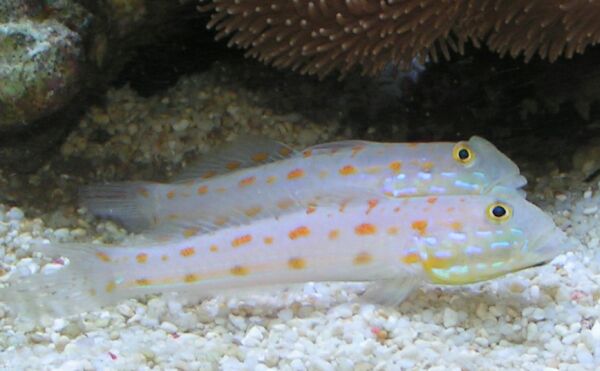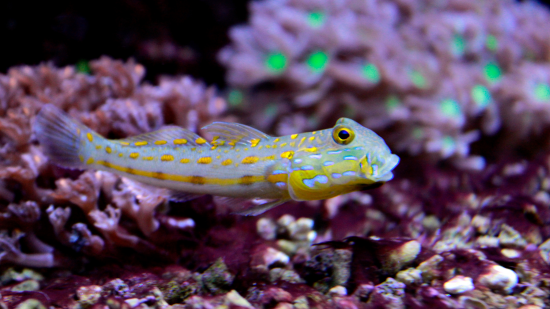Comprehensive Guide to Diamond Goby (Valenciennea puellaris)
Are you ready to dive into the mesmerizing realm of the Diamond Goby (Valenciennea puellaris)? Get ready to explore the captivating world of this remarkable fish species that inhabits the vibrant coral reefs. From its unique physical characteristics to its intriguing behavior and vital role in the ecosystem, the Diamond Goby has plenty to offer to marine enthusiasts and aquarium keepers alike.
In this comprehensive guide, we will take you on a journey through the life of the Diamond Goby, unraveling its secrets and shedding light on its fascinating lifestyle. Whether you are a seasoned aquarist, a marine biology enthusiast, or simply curious about the wonders of the ocean, this comprehensive guide is your gateway to understanding and appreciating the beauty of the Diamond Goby.
Join us as we delve into the depths of this extraordinary fish species. From its habitat and distribution to its diet and feeding habits, from its behavior and social structure to its conservation status, we will cover it all. By the end of this guide, you will have a comprehensive understanding of the Diamond Goby, its significance, and the measures taken to ensure its conservation in our ever-changing world.
So, let's embark on this underwater adventure and unravel the mysteries of the Diamond Goby together. Prepare to be amazed!
Table of Contents

No machine-readable author provided. Normann Z assumed (based on copyright claims)., Public domain, via Wikimedia Commons
Understanding the Diamond Goby: Species Overview
Detailed Description of the Diamond Goby
The Diamond Goby, scientifically known as Valenciennea puellaris, is a small but captivating fish species that belongs to the Gobiidae family. It is also commonly referred to as the Diamond Watchman Goby or the Maiden Goby. This fish showcases an array of intriguing features and behaviors that make it a favorite among marine enthusiasts.
With its elongated body and vibrant coloration, the Diamond Goby boasts an unmistakable appearance. Its body is generally pale to light gray, adorned with striking diamond-shaped patterns along its sides, giving rise to its common name. The Diamond Goby can grow up to 4 inches in length, making it a relatively small fish in comparison to other marine species.
Habitat and Distribution
The Diamond Goby is primarily found in the Indo-Pacific region, including the Red Sea, the Maldives, the Philippines, and parts of Australia. It inhabits coastal areas, lagoons, and sandy substrates, where it creates burrows and constructs intricate tunnel systems.
These burrows serve as both a shelter for the Diamond Goby and a means of hunting for food. The species is well adapted to living in sandy environments, using its specialized mouth to sift through the substrate in search of small invertebrates and organic matter.
Physical Characteristics
Besides its distinctive diamond-shaped patterns, the Diamond Goby possesses a variety of physical characteristics that contribute to its unique appearance and survival in its environment.
One notable feature is its elongated and slender body, which enables it to navigate through narrow tunnels and crevices with ease. It has two dorsal fins, with the first dorsal fin being taller and more pronounced. The caudal fin, or tail fin, is rounded.
The Diamond Goby has a pair of large, protruding eyes, allowing it to maintain keen visual awareness of its surroundings. Its mouth is positioned on the underside of its head and is equipped with small, brush-like teeth that aid in the capture of tiny prey.
Diamond Goby Behavior and Lifestyle
Typical Behaviors
The Diamond Goby exhibits a range of fascinating behaviors that make it a captivating species to observe in both the wild and aquarium settings. One of its notable behaviors is its burrowing nature. It spends a significant amount of time constructing and maintaining its burrow, which serves as its shelter and hunting ground.
Additionally, the Diamond Goby is known for its symbiotic relationship with pistol shrimp. These two species often form a mutually beneficial partnership where the goby acts as a lookout, warning the shrimp of potential predators, while the shrimp keeps the burrow clean and provides protection.
Social Structure and Mating Habits
Diamond Gobies are generally solitary fish, preferring to establish their own territories. However, in certain cases, multiple gobies of the same species may coexist peacefully within a larger aquarium or in the wild if there is an abundance of suitable habitat.
During the mating season, male Diamond Gobies engage in courtship displays to attract females. These displays involve intricate movements and visual cues, often accompanied by vocalizations. Once a female selects a male, they engage in spawning behavior, where the female releases her eggs and the male fertilizes them externally.
Lifespan and Growth
The lifespan of the Diamond Goby typically ranges from 5 to 8 years, although proper care and optimal conditions in captivity can contribute to longer lifespans. As with most fish, their growth rate is influenced by factors such as diet, water quality, and tank size. Generally, Diamond Gobies experience rapid growth during their early life stages and reach their adult size within a year or two.
Diamond Goby Diet and Feeding Habits
Preferred Foods
The Diamond Goby is primarily a carnivorous species with specific preferences when it comes to food. In the wild, its diet mainly consists of small invertebrates, including worms, crustaceans, and tiny benthic organisms found within the sandy substrate.
In captivity, it is essential to provide a varied diet that replicates their natural feeding preferences. This can include live or frozen foods such as brine shrimp, small pieces of fish or shrimp, and specialized commercial marine pellet or flake foods formulated for carnivorous fish.
Feeding Strategies and Habits
To obtain its food, the Diamond Goby employs a feeding strategy known as sand sifting. Using its protractile mouth, it sifts through the sand, extracting small organisms and edible particles. The sand is expelled through the gills, while the captured prey is consumed.
It's important to note that the Diamond Goby should be provided with a substrate that allows for this feeding behavior, such as fine sand or crushed coral, which enables them to sift through without causing harm or ingesting harmful substances.
Role in the Ecosystem
The Diamond Goby plays a significant role in maintaining the health and balance of the ecosystem in which it resides. Its feeding habits help control the population of small invertebrates within the substrate, preventing overgrowth and maintaining a healthy ecological equilibrium.
Furthermore, the burrowing activities of the Diamond Goby can have a positive impact on the health of coral reefs. By creating burrows, they facilitate water circulation and sediment turnover, which contributes to the overall health and productivity of the reef ecosystem.
Keeping Diamond Gobies in Aquariums
Suitable Aquarium Conditions
Creating a suitable aquarium environment is crucial for the well-being of Diamond Gobies. Here are some key considerations:
- The aquarium should have a sandy substrate to accommodate the burrowing behavior of the Diamond Goby.
- Provide plenty of hiding spots, such as rocks or PVC pipes, to create a sense of security for the fish.
- Maintain stable water parameters, including a temperature range of 75°F to 82°F (24°C to 28°C) and a pH level of 8.1 to 8.4.
- Ensure efficient filtration and regular water changes to maintain good water quality.
Compatibility with Other Species
Diamond Gobies are generally peaceful and can coexist with a variety of tankmates. However, caution should be exercised when selecting compatible species:
- Avoid keeping them with aggressive or territorial fish species that may harass or harm the Diamond Goby.
- Compatible tankmates can include other peaceful fish, small reef-safe species, and invertebrates such as shrimp and snails.
- Ensure adequate space and hiding places for each fish to reduce potential conflicts.
Feeding and Care in Captivity
Feeding Diamond Gobies in captivity requires providing a varied diet that meets their nutritional needs:
- Offer a combination of live or frozen foods such as brine shrimp, mysis shrimp, and finely chopped seafood.
- Supplement their diet with high-quality commercial marine pellet or flake foods formulated for carnivorous fish.
- Feed small portions multiple times a day to mimic their natural feeding behavior and prevent overeating.
- Regularly monitor water parameters and maintain a clean and well-maintained aquarium environment to promote the health and well-being of the fish.

Diamond Goby in Reef Aquarium
Health and Common Diseases in Diamond Gobies
Common Health Issues
While Diamond Gobies are generally hardy fish, they can still be susceptible to certain health issues. Some common health problems include:
- Parasitic infections, such as ich (white spot disease) or flukes.
- Bacterial or fungal infections, which can manifest as skin lesions or fin rot.
- Stress-related issues caused by poor water quality, aggressive tankmates, or improper handling.
Preventative Care and Treatment
To maintain the health and well-being of Diamond Gobies, it's important to implement preventative care measures and promptly address any health concerns:
- Maintain excellent water quality through regular testing, proper filtration, and routine water changes.
- Quarantine any new additions to the aquarium to prevent the introduction of diseases.
- Provide a balanced diet and ensure proper nutrition to support their immune system.
- If health issues arise, consult with a qualified aquatic veterinarian or an experienced fish keeper to diagnose and treat the specific condition.
Signs of a Healthy Diamond Goby
Keeping a close eye on the overall health of Diamond Gobies is essential. Here are some signs of a healthy Diamond Goby:
- Active and alert behavior, regularly exploring the aquarium.
- Bright and vibrant coloration, with no signs of discoloration or lesions.
- Normal eating habits, showing a healthy appetite and actively feeding.
- Clear and undamaged fins, free from any signs of fin deterioration or abnormalities.
Conservation Status of Diamond Gobies
Current Conservation Status
The Diamond Goby (Valenciennea puellaris) is currently listed as a species of least concern on the IUCN Red List of Threatened Species. This means that, based on available data, the population of Diamond Gobies is considered stable, and there are no immediate threats to their survival as a species.
Threats and Challenges
Despite their stable conservation status, Diamond Gobies still face certain threats and challenges that can impact their populations:
- Destruction of their natural habitat due to coastal development, pollution, and destructive fishing practices.
- Climate change and rising ocean temperatures, leading to coral bleaching and habitat degradation.
Conservation Efforts
Several conservation efforts and initiatives are in place to protect and preserve the Diamond Goby and its habitat:
- Establishment of marine protected areas and marine reserves to safeguard their natural habitats.
- Implementation of sustainable fishing practices and regulations to ensure responsible collection for the aquarium trade.
- Research and monitoring programs to gather data on population dynamics, habitat health, and the effectiveness of conservation measures.
